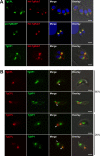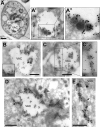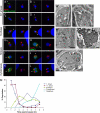Cathepsin L occupies a vacuolar compartment and is a protein maturase within the endo/exocytic system of Toxoplasma gondii
- PMID: 20444089
- PMCID: PMC2909120
- DOI: 10.1111/j.1365-2958.2010.07181.x
Cathepsin L occupies a vacuolar compartment and is a protein maturase within the endo/exocytic system of Toxoplasma gondii
Abstract
Regulated exocytosis allows the timely delivery of proteins and other macromolecules precisely when they are needed to fulfil their functions. The intracellular parasite Toxoplasma gondii has one of the most extensive regulated exocytic systems among all unicellular organisms, yet the basis of protein trafficking and proteolytic modification in this system is poorly understood. We demonstrate that a parasite cathepsin protease, TgCPL, occupies a newly recognized vacuolar compartment (VAC) that undergoes dynamic fragmentation during T. gondii replication. We also provide evidence that within the VAC or late endosome this protease mediates the proteolytic maturation of proproteins targeted to micronemes, regulated secretory organelles that deliver adhesive proteins to the parasite surface during cell invasion. Our findings suggest that processing of microneme precursors occurs within intermediate endocytic compartments within the exocytic system, indicating an extensive convergence of the endocytic and exocytic pathways in this human parasite.
Figures










Similar articles
-
Intersection of endocytic and exocytic systems in Toxoplasma gondii.Traffic. 2018 May;19(5):336-353. doi: 10.1111/tra.12556. Epub 2018 Mar 25. Traffic. 2018. PMID: 29437275 Free PMC article.
-
Toxoplasma Cathepsin Protease B and Aspartyl Protease 1 Are Dispensable for Endolysosomal Protein Digestion.mSphere. 2020 Feb 12;5(1):e00869-19. doi: 10.1128/mSphere.00869-19. mSphere. 2020. PMID: 32051238 Free PMC article.
-
Toxoplasma gondii cathepsin L is the primary target of the invasion-inhibitory compound morpholinurea-leucyl-homophenyl-vinyl sulfone phenyl.J Biol Chem. 2009 Sep 25;284(39):26839-50. doi: 10.1074/jbc.M109.003780. Epub 2009 Jul 13. J Biol Chem. 2009. PMID: 19596863 Free PMC article.
-
Secretory organelle trafficking in Toxoplasma gondii: A long story for a short travel.Int J Med Microbiol. 2018 Oct;308(7):751-760. doi: 10.1016/j.ijmm.2018.07.007. Epub 2018 Jul 21. Int J Med Microbiol. 2018. PMID: 30055977 Review.
-
Preparing for an invasion: charting the pathway of adhesion proteins to Toxoplasma micronemes.Parasitol Res. 2006 Apr;98(5):389-95. doi: 10.1007/s00436-005-0062-2. Epub 2005 Dec 30. Parasitol Res. 2006. PMID: 16385407 Review.
Cited by
-
A Toxoplasma gondii putative amino acid transporter localizes to the plant-like vacuolar compartment and controls parasite extracellular survival and stage differentiation.mSphere. 2024 Jan 30;9(1):e0059723. doi: 10.1128/msphere.00597-23. Epub 2023 Dec 5. mSphere. 2024. PMID: 38051073 Free PMC article.
-
Proteases as regulators of pathogenesis: examples from the Apicomplexa.Biochim Biophys Acta. 2012 Jan;1824(1):177-85. doi: 10.1016/j.bbapap.2011.06.002. Epub 2011 Jun 13. Biochim Biophys Acta. 2012. PMID: 21683169 Free PMC article. Review.
-
Vacuolar protein sorting mechanisms in apicomplexan parasites.Mol Biochem Parasitol. 2016 Sep-Oct;209(1-2):18-25. doi: 10.1016/j.molbiopara.2016.01.007. Epub 2016 Feb 1. Mol Biochem Parasitol. 2016. PMID: 26844642 Free PMC article.
-
Cryptic organelle homology in apicomplexan parasites: insights from evolutionary cell biology.Curr Opin Microbiol. 2013 Aug;16(4):424-31. doi: 10.1016/j.mib.2013.07.015. Epub 2013 Aug 8. Curr Opin Microbiol. 2013. PMID: 23932202 Free PMC article.
-
ATG8 localization in apicomplexan parasites: apicoplast and more?Autophagy. 2014 Sep;10(9):1487-94. doi: 10.4161/auto.32183. Epub 2014 Aug 4. Autophagy. 2014. PMID: 25102412 Free PMC article. Review.
References
-
- Barrett AJ. Cathepsin G. Methods Enzymol. 1981;80(Pt C):561–565. - PubMed
-
- Botero-Kleiven S, V F., Lindh J, Richter-Dahlfors A, von Euler A, Wahlgren M. Receptor-mediated endocytosis in an apicomplexan parasite (Toxoplasma gondii). Exp Parasitol. 2001;98:134–44. - PubMed
-
- Bradley PJ, Boothroyd JC. The pro region of Toxoplasma ROP1 is a rhoptry-targeting signal. Int J Parasitol. 2001;31:1177–1186. - PubMed

